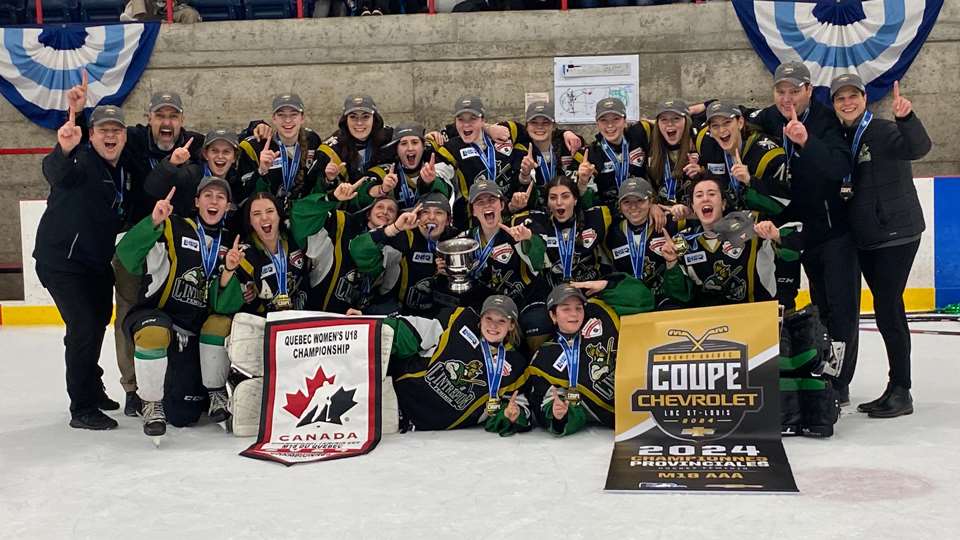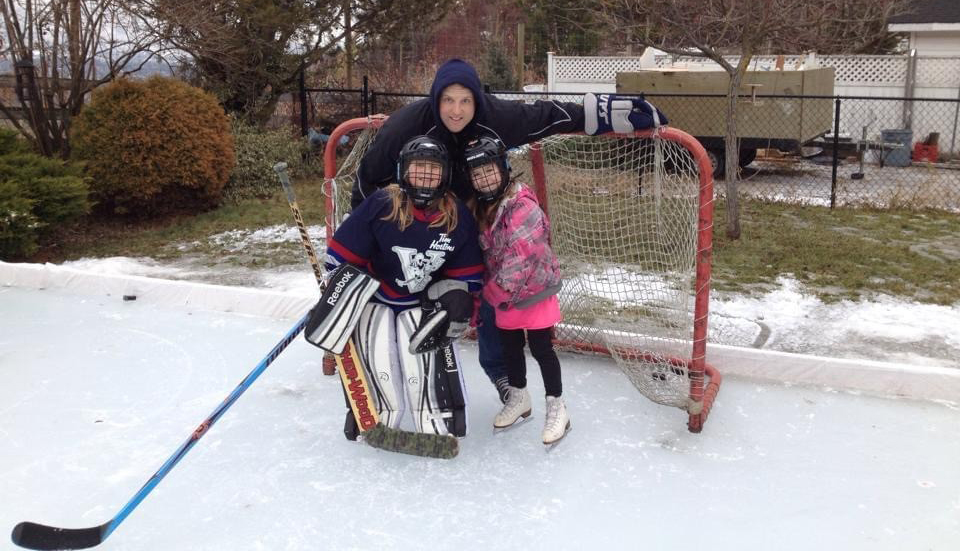
Schedule
Team Canada (Men)
IIHF World Junior Championship | Dec. 26, 2024-Jan. 5, 2025
Spengler Cup | Dec. 26-31, 2024
4 Nations Face-Off | Feb 12-20, 2025
IIHF U18 World Championship | April 23-May 3, 2025
IIHF World Championship | May 9-25, 2025
U17 World Challenge | Nov. 3-9, 2024
Hlinka Gretzky Cup | Aug. 5-10, 2024
Junior A World Challenge | Dec. 9-15, 2024
National Junior Team vs. USPORTS | Dec 12-13, 2024
Search

Generosity in a time of need
When a historic storm brought flooding and landslides to southern British Columbia, Aynsley D’Ottavio relied on acts of kindness to help get her back home to Chilliwack

When Aynsley D’Ottavio left her home in Chilliwack, B.C., to tour Quinnipac University in November, she never imagined how difficult it would be to get back home.
The Fraser Valley Rush defenceman and her mother made the trip to Connecticut with the intent of touring the university for one day before returning home.
“We got in [to Connecticut] that night and my dad texted my mom and said that a storm was going on [back home],” D’Ottavio says. “It didn’t really affect us too much because we do live in B.C. and there’s a lot of rain.”
Not thinking much of the precipitation, they went to sleep after the long travel day in preparation for the tour in the morning. The next day, they continued to receive updates about the unprecedented amount of rain they were getting back home.
“I toured the school all day, and kind of was hearing about everything as the day went on,” D’Ottavio says. “And then flying home that night, [that’s when we] found out that it got really bad.”
A historic rainstorm brought some B.C. communities nearly a month’s worth of rain within the span of 48 hours. The storm broke dozens of rainfall records and caused devastating landslides that closed almost every major highway in southern B.C.
After an already rain-filled September and October in the Fraser Valley, the latest dump overwhelmed creeks and rivers that wouldn’t normally be flood risks. Entire regions of the Fraser Valley became ingulfed by floodwaters. About 20,000 people were forced to flee their homes due to the storm.
The original plan was for D’Ottavio’s father to pick her and her mother up at the airport to drive the 16-year-old to Langley so she could join the Rush to face the Northern Capitals. While laid over in Toronto, D’Ottavio found out that the storm ruined that plan.
“We were kind of at a loss as to what to do because my dad couldn’t get through the flooding to pick us up,” she says. “We got into Vancouver, and my mom’s boss generously got us a hotel in Vancouver. We stayed there for a night and just kind of assessed the situation.”
D’Ottavio was not the only member of the Rush that was impacted by the floods. Forward Hannah Dods was at home in Chilliwack when the storm began. At first, the 15-year-old didn’t think too much about the incoming storm, but hearing about the beginning of the flooding and the height of the water in the rivers grabbed her attention.
“The night before I remember I was with my friend and we were talking about how much it was raining and we’re like, ‘Do you think school might be closed?’ But we were completely doubting it,” she says. “The next thing you know, school’s closed.”
Thankfully, both Dods and D’Ottavio’s family homes were not affected by the flooding in Chilliwack. Dods’ school would end up staying closed for an entire week and became a refuge for people affected by the flooding. Although Dods’ home was unaffected, she did witness the effects of her hometown being cut off by the natural disaster.
“Literally any kind of resources you would usually get, we’re not getting fed with any new supplies or anything,” she says. “We can’t waste the fuel we have because we can’t get more. We can’t eat all our groceries because if we go to the store, there’s no groceries because no supplies are getting in and out of Chilliwack.”
With the highways blocked by debris and water, there was no way for Dods to get to Rush practices or games. It did offer a silver lining, though—the 15-year-old was able to participate more on her basketball team.
“It was good to have chill time, but probably the one thing that disappointed me the most was definitely missing out on my hockey,” Dods says. “I think I missed a game and a couple practices, and not seeing my teammates for a week was like, ‘I can’t wait to get back out there.’”
Back in Vancouver, D’Ottavio was making calls to her teammates to see what she could do for their upcoming games against the Capitals.
“We had a game the next day in the morning, so we got a hold of some teammates and kind of just saw if we could put together a ride to even watch the game,” D’Ottavio explains.
With plans underway to try to get herself to Langley, she thought of an idea. Many of her teammates have old hockey gear in their homes. If she was unable to have her own equipment with her due to the flooding, what if her teammates could piece together a set for her?
“It was great,” she says. “I brought up the idea of getting some gear and everybody was just so on board with it and really wanted to see me on the ice, which was great because I really wanted to be on the ice and play with everybody. It was really awesome.”
Decked out in a set of hockey gear cobbled together from several teammates, the practicality of the idea hit when she stepped out on the ice.
“It was so awkward, and it was so weird,” D’Ottavio says. “Skating at first, I didn’t think I was going to be able to do it. Different skates are so tough to get used to just to begin with, but ones that are already broken in and old skates, it was so tough.”
Despite the discomfort, she recorded an assist in the Rush’s 3-2 overtime win. With the game complete, the next challenge was how to return home. D’Ottavio and her mother joined her defence partner Jade Lore and Lore’s mother to see if they could find a way home without using the closed roads.
Their first thought was to drive to Pitt Meadows Airport, a regional airport about 32 kilometres from Vancouver International Airport, to see if they could find a small plane that could fly them home, but there was no availability.
“We didn’t even have it in mind, but we saw the helicopter service across the street and asked them if they had any availability,” she says. “It turned out that somebody had cancelled, or they just had room and they were generous enough to give us a ride.”
In her first helicopter ride, D’Ottavio had a birds-eye view to see devastating flooding in her community first-hand.
“It was crazy. I couldn’t even recognize roads. There’s a highway that cuts right through, we couldn’t even make out where the highway was. It was worse than I would have imagined,” she says.
Although the circumstances surrounding the historic storm were difficult, the generosity of those willing to help in the community was always present. Several hockey associations in surrounding areas helped those affected by the natural disaster. Dods says her family assisted with filling up sandbags at a nearby park.
“It felt cool seeing all these people coming together,” Dods says.
D’Ottavio is thankful for all the generous acts that helped her and her mother return home. As the city worked to repair the damages, she remembers the positivity the community had for those most affected.
“Everybody was rallying around the farmers and the people living in the floodplains that were affected and had to leave their homes,” D’Ottavio adds. “The pilot told us that a bunch of plane and helicopter services were giving people free rides across the water to get them home to their families or people that had just left for work in the morning and just couldn’t get home. It was really awesome to see.”
Although lots of the infrastructure damaged by the storm has been repaired, there are still signs of the flooding six months later. Once the roads in and out of town re-opened, D’Ottavio and Dods were happy to be back with the Rush on their road to the Esso Cup.
For more information: |
- <
- >
































 And that’s exactly what he’s done. This past summer, Roberston built a dressing room for the Lakers inside Kal Tire Place. A business owner and contractor by trade, Robertson covered the majority of the construction costs — close to $7,000 — and secured sponsorship funding to cover whatever was outstanding.
And that’s exactly what he’s done. This past summer, Roberston built a dressing room for the Lakers inside Kal Tire Place. A business owner and contractor by trade, Robertson covered the majority of the construction costs — close to $7,000 — and secured sponsorship funding to cover whatever was outstanding. 













